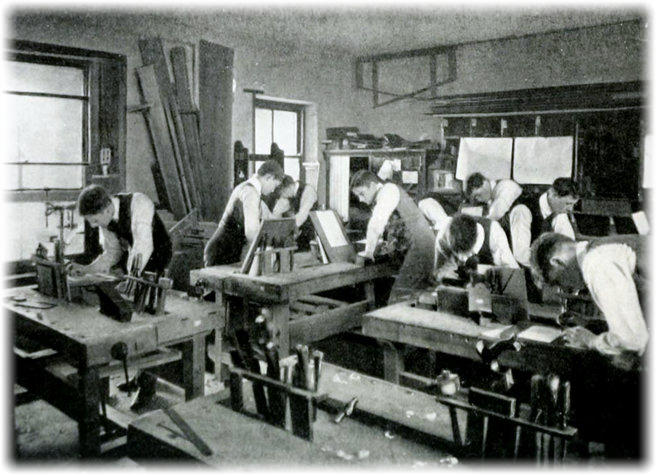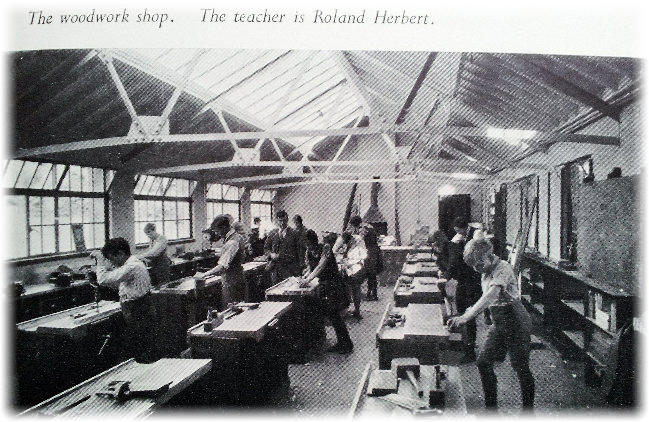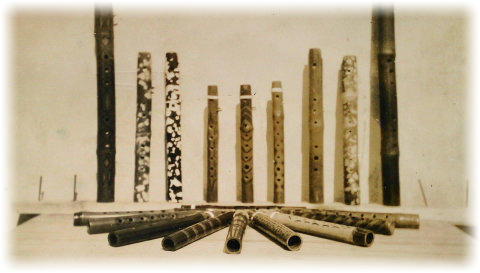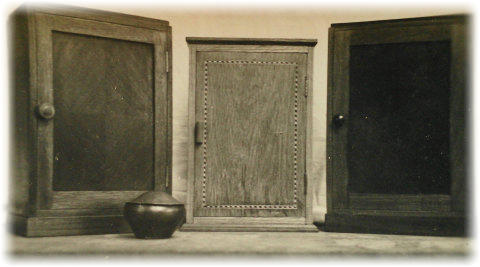
Updated - 22 October 2018
Copyright - G P Sagar 2015

The Quaker Influence
The superior man is distressed by the limitations of his ability; he is not distressed by the fact
that men do not recognize the ability that he has.
Confucius
‘A boy or girl’ is better trained to think by associating action with thought than by the exclusively bookish
forms of instruction.’
James Harrod, Headmaster of Sibford 1906 – 1930
He worked out a policy whereby such subjects as English, history, geography, and mathematics should be correlated as far
as possible with manual training. (Pestalozzi advocated this a century before).

“There
has
been
a
workshop
at
Sidcot
from
the
earliest
days
of
the
School’s
existence;
but
until
comparatively
recent
times
Carpentry
was
solely
a
leisure
occupation.
At
the
present
day
a
regular
course
of
Joinery
forms
part
of
the
curriculum
of
all
boys
except
those
in
the
Fifth
and
Sixth
Forms;
and
the
scholars
have
the
great
advantage
of
careful
and
systematic
training
by
one
of
the
Staff,
under
whose
skilful
direction
a
high
standard
of
excellence
has
been
attained.
The
Four
Years’
Course
includes
the
construction
of
thirty
graduated
models,
of
each
of
which
a
plan
elevation
and
projection
must
be
made
before
the
actual
work,
which
involves
the
use
of
all
ordinary
tools,
is
begun.
Lessons
are
also
given
on
the
construction,
uses
and
treatment
of
tools,
and
on
the
growth,
felling,
seasoning
and
uses
of
timber.
Good
as
the
work
has
been
so
far,
it
may
be
confidently
expected
that
the
recent
generous
promise,
by
James
Tangye,
of
all
the
costly
apparatus
and appliances of his own elaborately equipped workshop, will lead to results greater and more striking still.”
A HISTORY OF SIDCOT SCHOOL 1808-1908 BY FRANCIS A. KNIGHT LONDON: J M. DENT & CO. MCMVIII
In
1837
Thomas
Pumphrey
opened
a
workshop
for
boys
at
Ackworth,
and
in
the
same
year
similar
work
was
started
at
Bootham.
In
the
early
forties
we
read
of
a
lathe,
a
bench
and
tools
in
use
at
Penketh,
and
of
bookbinding
and
craft-work
at
Rawdon.
Sidcot
includes
work
in
wood
among
the
activities
for
boys
in
the
fifties,
and
Joseph
Pease,
a
Quaker
philanthropist,
provided
lathe,
bench,
and
tools
for
a
workshop
at
Wigton
in
187
I
.
An
account
of
the
development
of
work
in
drawing
and
woodwork
at
Saffron
Walden
shows
the
craft
to
have
beginnings
about
the
middle
decade
of
the
nineteenth
century.
By
the
eighties
we
find
the
work
at
Ayton
such
that
pupils
were
making
knife-boxes,
book-
shelves,
deck-chairs,
coal-boxes,
and
some
did
inlaid
work.
I900
an
exhibition
of
craft-work
done
at
Leighton
Park
showed
good
results
from
work
on
the
lathe,
and
included
examples
of
cabinet-making
and
model-yacht
building.
The
Board’s
Inspector
at
Sibford
in
1903
says
that,
in
a
workshop
which
is
really
too
small,
the
standard
of
work
achieved
is
really
excellent,
both
in
plan-drawing
and
accurate
execution.
He
con
siders
the
planning
of
the
course
very
good,
including
as
it
did
‘an
adequate
number
of
joints
as
ground-work’
which
were
executed
to
a
much
better
standard
than
the
average
work
of
boys.
He
also
commended
the
boys
and
their
teacher
for
the
construction,
with
a
little
help
from
the
village,
of
the
excellent
pavilion
on
the
playing-field.
There
is
much
other
evidence
of
a
strong
tradition of craft-work in the schools.
Penketh
had
advanced
so
far
in
workshop
equipment
as
to
have
a
lathe,
bench
and
tools.
In
this
lean-to
workshop
on
the
side
of
the
boys’
playground,
an
eyewitness
has
left
on
record
that
Thomas
George
Howell
(1838-45),
built
and
rigged
a
fine
three
masted
model
ship,
for
which
he
made
bales
and
barrels
for
cargos
and
furnished
it
with
guns
in
the
upper
deck
for
protection
from
pirates.
The
guns
were
duly
charged
with
powder,
and
had
fuses
of
touch-paper.
The
mimic
battery
discharged itself as the vessel sailed towards the middle of the pond on the common, not far from the Friends’ Meeting House.
One
craft
teacher
at
Sibford,
Reg
Rowntree
introduced
an
early
structured
approach
to
his
teaching,
which
in
a
loose
way
included
element
of
design.
When
a
boy
joined
the
school
he
was
required
to
choose
a
board
of
timber
from
the
'dying
shed'.
Throughout
his
course
he
would
look
after
that
particular
board,
bringing
it
into
the
workshop
to
be
stored
on
the
roof
trusses
for
final
seasoning
before
working
on
it.
His
final
task
was
to
produce
a
piece
of
work
from
that
board
which
he
would
plan
and design himself.

Some Examples of Early Sibford Craftwork






These were also the days when teachers tended to reside in one job for large periods of their careers. Roland Herbert,
craft master at Sibford was there for thirty one years.
Examples of boy’s work, although the school was co-educational, can be found on this link to my
Memories of Sibford.
James T Bailey was perhaps the most influential exponent. His work and experience being detailed in his biography -
Baily, L. (1959) Craftsman and Quaker: The Story of James T. Baily 1876-1957. London: George Allen and Unwin.
This
boy,
in
his
after
life
reminiscences,
tells
of
that
day
of
supreme
excitement
—the
5th
November
-
which
the
school
celebrated
as
Guy
Fawkes
day,
with
a
good
display
of
fireworks,
and
a
bonfire
withal,for
which
their
Quaker
friends,
the
Crosfields of Warrington, sent a cartload of resin barrels
From
their
Soap
Works.
What
a
blazing
event
it
must
have
been,
for
it
attracted
the
people
of
the
village
and
the
country
around!
One
of
these
celebrations,
Richard
Routh
the
first
Superintendent
of
the
Friends’
School
at
Sibford
Ferris,
in
Oxfordshire,
had
the good fortune to witness on the occasion when he visited Penketh School to get an insight into its working.
The
school
of
the
present
has
therefore
a
just
claim
of
presedent
for
keeping
up
the
day
,
which
is
really
the
survival
of
the
much older custom of the old Beltane fires , which Druid priests kindled on the hills of Lancashire.


- Personal Work Index Page
- Sophie's Egg
- The Marlin Trophy
- Rose Bowl
- Silver Cup
- Music Stand
- The Gilchrist Bowl
- Silver Golfing Marker
- Walking Stick Handles
- Turnery Work
- Other Silver Work
- Platinum Ear Drops
- General Woodwork
- The Pararule
- Oliver's Money Box
- Rings and Ring Making
- Bracelets
- Necklaces & Pendants
- Box Making
- Oak Kitchen
- Jonas Feilding Presentation
- Building / Renovation Project
- Communion Set Repair


- History of Craft Education
- Preface
- Introduction
- Setting the Scene
- Towards Design and Technology
- Historical Aspects
- The Plato Gap
- Kill the Skill
- The Colleges and Teacher Training
- The Professional Association
- The Quaker Influence
- Where Are We Now
- Personal Reflections
- Acknowledgements and Resources
- Notes
- Timeline




